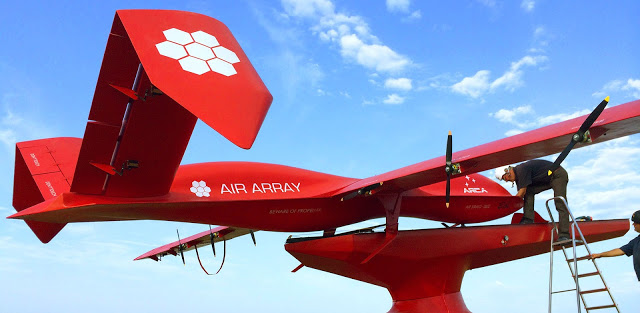Arcaspace has $80,000 and $140,000 stratospheric electric drones.
The Explorer is a stratospheric flying robot is the current top of the line unmanned aerial vehicle from Arcaspace. It has a flight ceiling of 60,000 ft (18,000 m) using solar cells and batteries or 13,000 ft (4,000 m) using hybrid propulsion with power generator and batteries, almost a day of endurance and the capability to be controlled via satellite or GSM communication over the Internet is far beyond any other civilian unmanned aerial vehicle can provide for this price range. The generous payload space and weight make it suitable for a wide range of applications. The high flight ceiling and great autonomy allows you to perform flights in near space conditions for long durations.
The software installed in the flight computers has artificial intelligence attributes. Not only it can hold a flight course and follow specific points, but it can also take decisions based on predetermined conditions. For instance, it prevents the pilot to enter a restricted area; in case the connection between AirStrato and the Interface is lost, the aircraft can call by itself the technical support at ARCA SPACE CORPORATION while maintaining a steady course; in case all contact both with its pilot and technical support at ARCA is lost, AirStrato will fly to a predetermined safe area and altitude and deploy the recovery parachute.
The autopilot can maintain the altitude and course or follow way-points inserted into the flight path. The autopilot is very friendly, way-points can be inserted, deleted, re-organized, or saved on the Interface ground station or in the aircraft computer. The autopilot can also control the on-board camera to target specific locations and film them for a pre-determined period of time.
All connections between the UAV and and the ground station use Transport Layer Security and are encrypted with the AES 256 standard, that is the best possible encryption for civilian applications. The UAV on-board computer features snapshot algorithm to prevent tampering with system and avionics files. The connection server has a demilitarized zone protection with double firewall and Intrusion Detection and Prevention systems to block hacker intrusion. Also several servers in different locations, in US and EU are available as redundancy that are ready to takeover the workload in case one ore more servers encounter denial of service attacks. All of these features provide you with the best security you can possibly have for a civilian remote controlled aircraft.
The Explorer is currently under tests and is available for pre-order at a 20% price reduction. Commercial production began in August 2015. After the commercial production will start, customers who pre-ordered will be able to purchase this model and future AirStrato models at a 10% price reduction for a period of one year.
The drones can be outfitted with high definition or 4K definition cameras. Cargo containers can be added to hold 100 pounds.
Dimensions
Wingspan 16 m 52.5 ft Length 7 m 23.1 ft Height 1.6 m 5.3 ft Wing area 19.2 m2 206.7 ft2 Power plant Robbe 8085/10 45 Volts Engine thrust at sea level 6 x 20 kgf 6 x 44 lbf Power source Solar cells 6 inch polycrystalline 6 inch polycrystalline Installed power of solar cells 2,800 W 2,800 W Power generator for hybrid version 5,100 W 5,100 W Range 1800 km (1120 miles)
Lightweight composite airframe
This is the lightest composites airframe they can construct. It doesn’t get any lighter than this. But it is also strong, flexible and durable. And because radio waves can pass right through the fuselage, you don’t have to mount outside antennae to affect its aerodynamic performance. Or its beauty.
The electric motors are powered, beside the internal batteries, by an array of solar cells placed on the aircraft wing. These provide enough power to keep you flying for hours. Flying at night? Just use the internal batteries instead, that are recharged during the day flight. The solar cells and internal batteries provide the Explorer with an autonomy of 20 hours. If your missions are requiring mostly night flights, then choose the hybrid version, with internal power generator and no solar cells.
The electric motors are used to propel the AirStrato to stratospheric altitudes. Compared with classic combustion engines, the electric motors do not require air to function and their performance is not affected by the increased altitude. However, the aircraft propellers will offer lower thrust as the altitude increases. The motors can be throttled from zero to full thrust in less than two seconds. The propeller thrust can be continuously adjusted from the Interface’s throttle handle.
The recovery parachute has a diameter of 43 ft (13m) and it is placed in a rear fuselage container. It can be used to bring AirStrato on the ground, on any place you may want, independently from a runway. It can also be used in case of emergencies. Just press two buttons from the stick. The first button will arm the parachute system and the second button will deploy it. The parachute can be quickly repacked and reused.

Brian Wang is a Futurist Thought Leader and a popular Science blogger with 1 million readers per month. His blog Nextbigfuture.com is ranked #1 Science News Blog. It covers many disruptive technology and trends including Space, Robotics, Artificial Intelligence, Medicine, Anti-aging Biotechnology, and Nanotechnology.
Known for identifying cutting edge technologies, he is currently a Co-Founder of a startup and fundraiser for high potential early-stage companies. He is the Head of Research for Allocations for deep technology investments and an Angel Investor at Space Angels.
A frequent speaker at corporations, he has been a TEDx speaker, a Singularity University speaker and guest at numerous interviews for radio and podcasts. He is open to public speaking and advising engagements.







